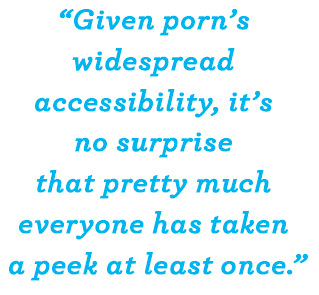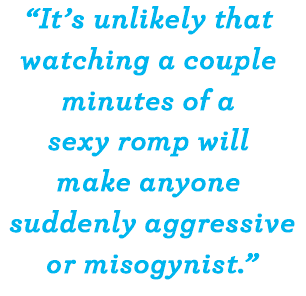Pornography has always been a touchy subject. When the first erotic novel, which followed the life of a London prostitute, was published in 1748, it was widely banned and persecuted. In the 1970s, when porn was just emerging as a film genre and was mostly financed by Mafia families, state and federal prosecutors quickly shut down the movies. Today, though porn is a lot less taboo and more accessible than ever, we’re still faced with scrutiny of sexual material, particularly when it comes to portrayals of women.
Although the research isn’t conclusive, there’s evidence that watching certain types of porn may be harmful to spectators and can change the way we think about gender equality, our intimate relationships, and even how we perform in the bedroom.
What’s the Deal?
With the advent of the Internet, the days of leafing through magazines or renting X-rated flicks have nearly gone extinct. Now, 90 percent of pornography consumption happens on the web and more than 26 million sites are dedicated to online nooky.
 Given porn’s widespread accessibility, it’s no surprise that many people have taken a peek at least once. A study of 813 university students found that 87 percent of men and 31 percent of women reported using pornography, while a Canadian researcher who attempted to locate male “porn virgins” couldn’t find a single guy that hasn’t watched it. And people aren’t just peering at porn in the comfort of their homes — viewers also include on-duty government workers such as U.S. SEC commissioners and British Parliament members, who were guilty of 300,000 attempts to view explicit videos while the U.K. legislature was in session. Watching online pornography is also the leading cause of corporate Malware among top executives.
Given porn’s widespread accessibility, it’s no surprise that many people have taken a peek at least once. A study of 813 university students found that 87 percent of men and 31 percent of women reported using pornography, while a Canadian researcher who attempted to locate male “porn virgins” couldn’t find a single guy that hasn’t watched it. And people aren’t just peering at porn in the comfort of their homes — viewers also include on-duty government workers such as U.S. SEC commissioners and British Parliament members, who were guilty of 300,000 attempts to view explicit videos while the U.K. legislature was in session. Watching online pornography is also the leading cause of corporate Malware among top executives.
It’s pretty clear that most humans have dabbled in the world of X-rated videos — and have the browser history to prove it.
Odds are good that all of these porn viewers are being exposed to potentially problematic depictions of women. One study, which analyzed 304 scenes in popular porn movies, found that 88.2 percent contained physical aggression, 48.7 percent contained verbal aggression, and 94.4 percent of aggressive acts were directed toward women
 Now, aggressive sex isn’t necessarily a bad thing (providing both partners have happily given consent, of course). But when virtually all the mainstream pornographic depictions of sex involve aggression toward women, it’s time to question what all this porn watching is doing to our attitudes about women, sex, and relationships in general.
Now, aggressive sex isn’t necessarily a bad thing (providing both partners have happily given consent, of course). But when virtually all the mainstream pornographic depictions of sex involve aggression toward women, it’s time to question what all this porn watching is doing to our attitudes about women, sex, and relationships in general.
Why It Matters
Even before it was an Internet sensation, sociologists, psychologists, and feminists were studying the effects of porn on behavior, attitudes, and relationships. Though they generally agreed that an occasional peek wasn’t that bad — in fact, looking at nudie pics may help reduce stress — researchers were concerned that more avid viewership (as well as watching violent and sadomasochistic porn) could provoke serious consequences such as sexist attitudes, aggression and violence against women, and even increased acceptance of harassment and rape (although this last finding remains a subject of debate)
 Current studies suggest the subject is more complex than researchers may have previously thought; there are a lot of factors at play when we watch porn. Several studies have found that pornography may indeed reinforce sexist attitudes, but predominantly in individuals who already hold strong sexist beliefs, score high for risks of aggression, and are low in agreeableness
Current studies suggest the subject is more complex than researchers may have previously thought; there are a lot of factors at play when we watch porn. Several studies have found that pornography may indeed reinforce sexist attitudes, but predominantly in individuals who already hold strong sexist beliefs, score high for risks of aggression, and are low in agreeableness
Perhaps surprisingly, sexist attitudes among porn viewers aren’t confined to the male domain: A longitudinal study found that when men and women were exposed to sexually explicit media as adolescents, both groups had less progressive views of gender roles
Because violence goes hand-in-hand with intimacy in many X-rated videos, some experts worry that porn can teach viewers that aggression is pleasurable to everyone — potentially motivating people to model that behavior during sex. Research has also found that pairing aggression with arousal can produce misogynistic attitudes, and may foster the belief that sexual satisfaction can always be achieved without affection and emotional attachment. This isn’t to say that people who watch aggressive porn are guaranteed to become violent sexual partners, but what these studies do suggest is that watching porn can change how we view pleasure in intimate relationships.
In response to these findings, an alternative porn movement is slowly building. One study found that Norwegian X-rated media depicts women in more empowering positions than American or Japanese porn, showing that porn does have the potential to portray women as equals. The feminist pornography movement has emerged as video producers and activists seek to portray women in more power-equal positions, show couples in more loving, intimate relationships, and provide safe and healthy working environments for sex workers of all genders. There are even plans to roll out a 24/7 porn channel for women in the U.S. next year (it’s currently available in the Netherlands). Meanwhile, countries such as England and Australia have outright banned violent pornography.
The Takeaway
Porn’s effects on its viewers are complicated, and it’s difficult to make sweeping statements because everyone’s cultures, beliefs, personalities, and porn preferences are different. And since most research focuses strictly on heterosexual porn, the LGBTQ community and LGBTQ-friendly porn are woefully unstudied.
That said, current studies generally agree that the sole act of watching porn won’t make anyone suddenly aggressive or hostile toward women (although certain individuals are at risk if they are already aggressive or hold sexist beliefs). But research does suggest porn may make us think differently about intimate relationships and influence people’s perceptions of what is acceptable and “normal” during sex.
The takeaway? There’s no need to scale down your porn habits (unless they’re interfering with normal daily life), but research suggests it’s a good idea to steer clear of the violent stuff and instead explore less aggressive, more relationship-friendly X-rated media. Thankfully, there’s more sex-positive porn out there today than ever before.
Got something to say? Share in the comments below or get in touch with us on Facebook!


